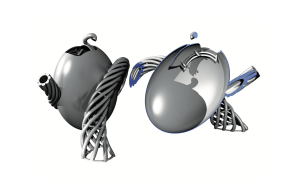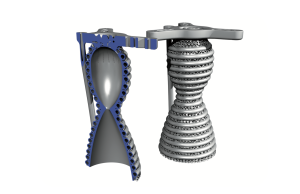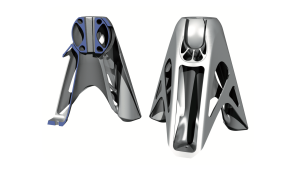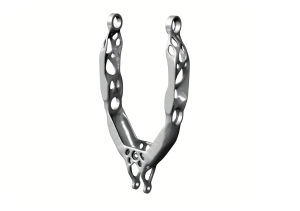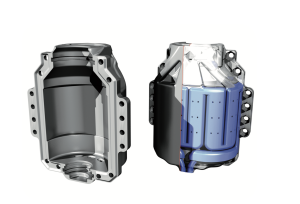Additive Industries, the Dutch company that has recently launched one of the most advanced and automated SLM-based, production-grade 3D printers on the market, organized a global contest asking both students and professionals to come up with the most proficient designs for industrial 3D printing. The six finalists (out of 47 contestants, both professionals and students) have now been announced and the winner will be presented at the upcoming Additive World Conference to be held on March 23rd in Eindhoven. Erik de Bruijn, chairman of the jury and co-founder of Ultimaker, will announce the winners.
The most difficult part of implementing a metal 3D printing production workflow is not getting the 3D printer to create a complex part as much as it is to know what designs will best exploit the advantages of additive manufacturing. Additive Industries launched the contest “in order to grow the number of examples and inspire many other industries to develop dedicated applications for industrial 3D printing.”
The finalists’ products redesigned for additive manufacturing by the finalists show a broad range of opportunities. They include designs from the aerospace field (liquid rocket nozzle, bell crank for an Airbus helicopter and an integrated bearing for satellite solar arrays), automotive industry (motor casing to convert motorcycle from gasoline to electric) and consumer markets (bicycle frame custom lugs and a teapot).
All products were selected for their ability to illustrate the freedom of the designer, along with the potential to reduce the number of parts or integrate them, the possibility to create lighter structures and vary the material properties within a part and for doing away with assembly requirements.
“The redesigns submitted from all over the world (USA, Belgium, Germany, UK, Spain, Egypt and Finland) demonstrate perfectly how product designs can be improved when the freedom of 3D printing is applied’, says Daan Kersten, co-founder and CEO of Additive Industries.
The large variation of industrial applications confirms the growing interest for additive manufacturing in multiple industries.
In the Professional category, the Spanish team ATOS SE showed how to benefit from the additive manufacturing capabilities by creating a new integrated orientation system concept, which unifies a multiple parts solution into a one-part design named “Aerospace Integrated Bearing.” Germany-based TUHH – Liebherr (Technical University of Hamburg-Harburg) optimized the design of the bell crank for an Airbus Helicopter for weight and cost reduction. The third finalist in the Professional category, American firm Smith & Nephew, developed a regenerative liquid rocket engine and designed the light-weight, regenerative cooling liquid rocket nozzle and combustion chamber.
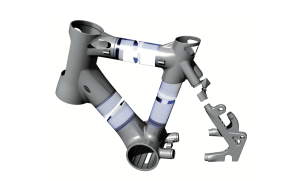
This is not the first 3D printed metal frame bike concept we see but each new projects finds new advantages in AM
The Student proposals were just as fascinating. The team ‘Custom Lugs’ from the Aalto University (Finland) used a high degree of freedom in design for their bicycle frame custom lugs, in order to reduce the amount of manual labour in the production of customized bicycle frames from steel. Cassidy Silbernagel, from the University of Nottingham (UK), assembled a custom electric motor into a cylinder casing and an existing crank shaft case through an innovative motor casing design. Egyptian student Menna Moustafa El Rewiny, finally, designed an untraditional teapot, far from symmetrical rounded forms and with a lid that is fully integrated into the body.
The first Additive World Design for Additive Manufacturing Challenge was first announced by Additive Industries during the Dutch Design Week, in Eindhoven, last October. Winners in both categories will take home the latest Ultimaker 2+ 3D printer and Autodesk’s NetFabb license. The top 3 in both categories get for free one year license of Altair’s Inspire software and one year subscription to Autodesk Fusion 360. Also the award winning designs will be printed in metal. Judging by the success of the initiative and the many benefits that it will have on the industry as a whole, there are going to be many more in the future.
- Team AtoS AM Engineering (Atos SE, Spain): aerospace integrated bearing (professional)
- Team TUHH – Liebherr (Technical University of Hamburg-Harburg, Germany): bell crank (professional)
- Cassidy Silbernagel (The University of Nottingham, UK): motor casing (student)
- Team Custom Lugs (Aalto University, Finland): bicycle frame custom lugs (student)
- Team Crius Tek (Smith & Nephew, USA): liquid rocket nozzle (professional)
- Menna Moustafa El Rewiny (Helwan University, Egypt): teapot (student)
Subscribe to Our Email Newsletter
Stay up-to-date on all the latest news from the 3D printing industry and receive information and offers from third party vendors.
You May Also Like
NSF Awards Kentucky $1M for Advanced Manufacturing
The National Science Foundation has awarded a $1 million grant to the University of Louisville for the Advancing Manufacturing and Building Construction Technologies (NSF AMT) project. This initiative is part...
3D Printing News Briefs, May 11, 2024: 3D Printed Stent, Tower, Sculptures, & More
We’re starting off with medical research in today’s 3D Printing News Briefs, as researchers in Korea used CT images and 3D printing to fabricate an educational simulator for a mastoidectomy....
3D Printing Unpeeled: Wind Turbines, Probiotics and Lenses
TPI Composites, ORNL and Ingersoll Rand are working to make wind turbine tooling segments that can be 18.3 meters long. These elements also include resistive wires that help keep the...
Tethon 3D Releases Cost-effective Bioprinter
Tethon 3D, known for its ceramic-loaded DLP materials, custom resins, and DLP 3D printers, has recently released a bioprinter. Vat polymerization printers like DLP systems have been widely used by...


